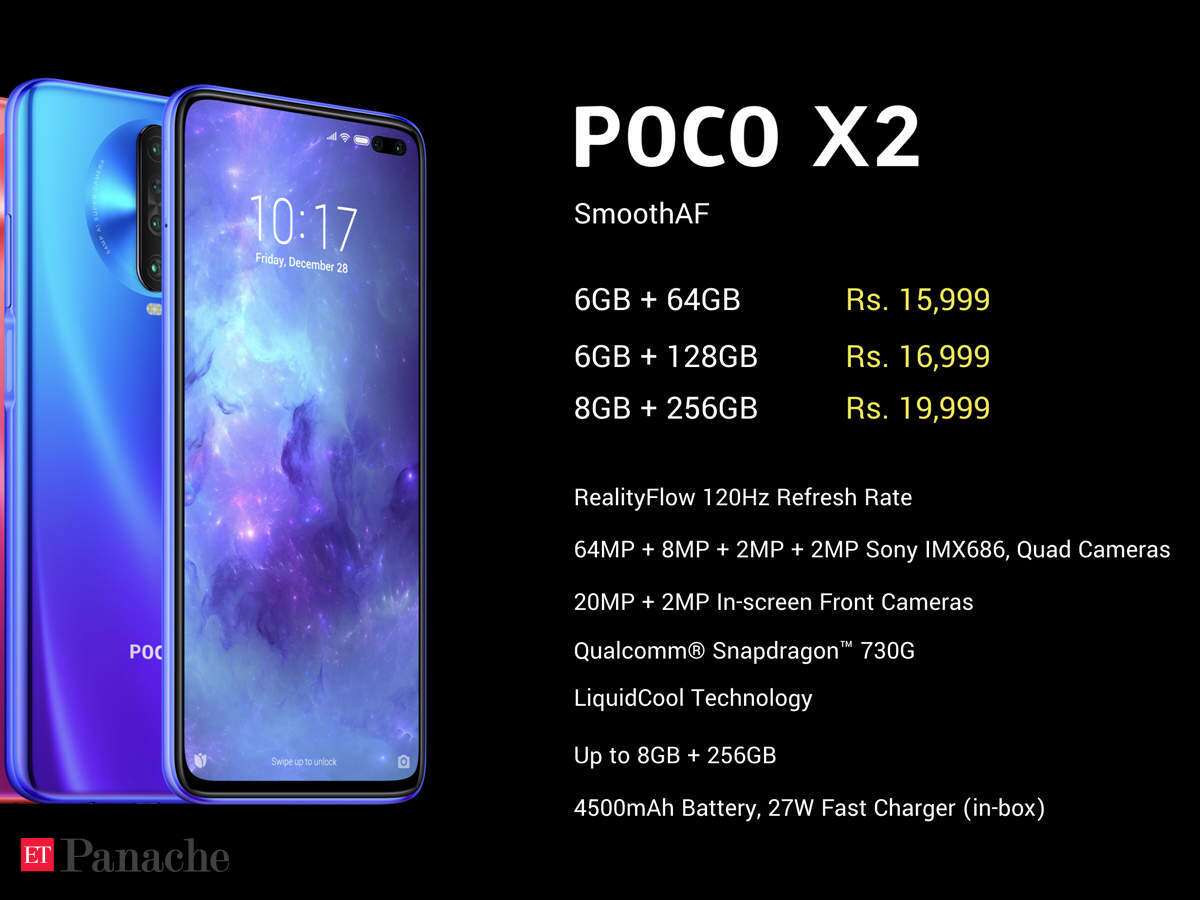Like many of its competitors, Xiaomi has spun the Poco sub-brand off into its own company, just in time for the launch of the Poco X2. The brand is of course well known because of the iconic Poco F1, but it has been well over a year since that model was launched. Poco is now on its own, though it will likely share many resources with Xiaomi for the foreseeable future. The new Poco X2 is sure to be noticed, however fans should be clear that this is not the next version of the Poco F1, and doesn’t follow the same formula at all. The Poco X2 is much more conventional and somewhat less path-breaking than its illustrious predecessor.
This phone isn’t made of plain plastic and isn’t trying to prioritise core specifications and raw power over everything else. Of course people are still expecting Poco to take the lead in terms of pricing, and to an extent, it does. Starting at just Rs. 15,999, the Poco X2 takes the Realme X2 (Review) on and somewhat overshadows the Redmi K20 (Review) as well as the Redmi Note 8 Pro (Review).
Will Poco set off another firestorm in the Indian market, and does this mark the beginning of a new era of competitiveness? We can’t wait to get started on our review to find out.
Poco X2 design
While the Poco F1 (Review) is unapologetically plain-looking and made of simple plastic in order to remain affordable, Poco is trying a different approach here. What we have is a bright, colourful glass rear with a gradient tone and an unusual circular design around the vertical camera strip. Our Atlantis Blue unit was lighter on the top and darker going down, but you can also choose Phoenix Red or Matrix Purple. There’s a Poco logo towards the bottom, and no “by Xiaomi” tag like the F1 had. The frame of the phone matches the colour of the lower one-third of the rear panel.
The main bit of design flair is the circular patch. You might think at first that Poco has gone with a raised camera module like what we’ve seen on the OnePlus 7T (Review) and Nokia 7.2 (Review), but it’s just a patch with a smooth finish while the glass around it looks frosted. Also, despite the fact that it’s quite flat, Poco has managed to make this patch reflective like a convex mirror, and we were somewhat able to frame a selfie taken with the rear camera. The vertical strip that actually houses the four cameras sticks out quite a bit and has slightly rough edges.
With a 6.67-inch screen, this is undoubtedly a large phone. The tall 20:9 aspect ratio helps with reachability and the non-slippery rear makes for a decent grip. It’s still difficult to get to all parts of the screen with a thumb though, making one-handed use potentially awkward. Your eye will be drawn to the wide dual-camera cutout in the upper right corner of the screen – it isn’t too noticeable in ordinary use, but definitely is a distraction when watching full-screen video.
The wide dual-camera cutout in the screen is quite noticeable
The power button on the right doubles as a fingerprint sensor, but it’s long and thin, which isn’t ideal. The fingerprint registration process took longer than usual, since the Poco X2 has to make sure it can work with just a narrow slice of your fingerprint. Left-handed users will find this placement awkward, and you’ll need to enrol at least two or three fingers so you can unlock the phone when it’s in your hand and on a table. The sensor is flush with the side of the phone which also meant we didn’t always line our fingers up with it perfectly.
The volume buttons are above the power button, which puts them slightly out of reach. There’s an infrared emitter on the top, like with many Xiaomi phones. Sadly, the tray on the left is of the hybrid variety so you’ll have to sacrifice a second SIM if you need a microSD card, and vice versa. There’s a 3.5mm audio socket, USB Type-C port, and speaker on the bottom.
Poco says it has used Gorilla Glass 5 for the front as well as rear of the X2. A clear transparent case comes with this phone and we’re glad to see there’s no pre-applied screen protector. You also get a SIM eject pin, a 27W charger, and a USB Type-C cable. The charger is one of the bulkiest we’ve ever seen.
Overall, it seems as though Poco wanted to create a distinct identity for the X2 and for itself as a brand. We’re not sure that all the design choices here are for the best, but this phone is at least unique and recognisable from the front as well as the back. We would have liked a neutral colour option, though.
The Poco X2 is available in three vibrant colour options
Poco X2 specifications and software
As we stated earlier, the Poco X2 should not be seen as the successor to the Poco F1, and as such it isn’t trying to offer a flagship-grade SoC at mid-range prices. You do get the Qualcomm Snapdragon 730G, which is pretty much the next best thing. This is the same chip that powers this phone’s primary competitor, the Realme X2, so we can assume that gaming and general-purpose performance will be solid.
You can buy the Poco X2 with 6GB of RAM and 64GB of storage for Rs. 15,999; 6GB of RAM and 128GB of storage for Rs. 16,999; or 8GB of RAM and a whopping 256GB of storage for Rs. 19,999. We have the top-end variant with us for review and if you choose this one, the hybrid dual-SIM tray won’t be much of a problem.
The 6.67-inch 2340×1080-pixel display has a killer feature to boast of – a 120Hz refresh rate. This is a subtle feature but it really does improve the quality of the usage experience, making the Android UI feel smooth and responsive. Poco calls this feature “RealityFlow” and it isn’t hard to see why. Games will benefit the most from this, but they have to explicitly support it and not a lot do yet. HDR-10 is also on the spec sheet.
There’s also a 4500mAh battery, dual VoLTE, Wi-Fi 802.11ac, Bluetooth 5, GPS, FM radio, and all the standard sensors. Interestingly, the design and specifications of the Poco X2 are practically identical to those of the Redmi K30 being sold in China. It will be interesting to see how the two brands segment and differentiate themselves if the Redmi K30 is launched here.
You’ll find a USB Type-C port, 3.5mm audio socket, and speaker on the bottom
Poco’s UI is identifed as Poco Launcher as well as MIUI 11.0.3 in different parts of the UI. It looks and feels like what we’ve seen recently on the Redmi K20 (Review) and Redmi K20 Pro (Review). It’s based on Android 10, and we have the December 2019 security update which is good to see.
Xiaomi’s software strategy has always been a point of contention and now Poco has inherited the same issues. There’s a lot of preloaded bloatware and we saw multiple annoying notifications each day asking us to download more through the company’s own GetApps store, or watch random celebrity-themed videos. There are also promotional messages on the lock screen, which you can disable. You’ll see ads and promoted content in many of the default apps. On the whole though, we noted that all this seems to have been toned down a little compared to what we’ve dealt with in the past.
Among the many preinstalled apps, you’ll find Mi Pay and Mi Credit, Xiaomi’s apps for UPI transactions and personal loans respectively. There’s are of course several redundant Mi apps including a Web browser, photo gallery and calendar, but some others such as Mi Remote, Themes, and Screen Recorder are useful. The third-party selection, including Helo, Gaana, Amazon Shopping, Dailyhunt, Opera, and more, are removable. The GetApps store will try to make you download plenty more, so be sure to look for the ‘Skip’ option.
There are plenty of UI customisation options. Not only is there now an app drawer, but it has tabs that filter various categories of apps for easy access. Nice touches include a search bar at the bottom of the drawer so you don’t have to stretch, and neatly grouped “Special features” in the Settings app. These features include the Game Turbo optimisation mode, Quick Reply panels for messaging apps, and Second Space for privacy.
There’s a fingerprint sensor integrated into the power button on the left
Poco X2 performance and battery life
The Snapdragon 730G is no slouch, and the Poco X2 breezed through all our apps and usage scenarios. We did see some very slight stuttering in UI once or twice but it was only momentary. Multitasking was not a problem at all. Of course, this experience applies to the top-end variant that we are testing, which has 8GB of RAM. The only problem we had was stretching our thumbs to reach all parts of the screen. The phone didn’t get too hot in use either, and we only felt a mild warmth when playing games or using the cameras for a while.
The screen isn’t the most vivid or crisp, but it is fairly bright and engaging, and viewing angles are great. Whether or not the wide dual-camera hole annoys you will be a subjective matter – we found ourselves largely forgetting it was there when watching videos, but then suddenly being distracted by it when a bright scene came on. We also noticed a bit of backlight unevenness around the cutout.
You only get a single speaker on the bottom of this phone but it’s very loud and the sound is impressively deep and rich. Music distorts if the volume level is above 60 percent or so, but anything less than that is fine for personal listening.
A few of our benchmark tests were restricted from running on our pre-release review unit, but we do have some numbers to share. AnTuTu gave us a score of 2,80,912 which is very good. The Geekbench 5 single-core and multi-core scores were 548 and 1,759. 3DMark and GFXBench were both unable to run so we don’t have graphics scores, but we did run some of today’s more demanding games and got some real-world experience with the Poco X2.
PUBG Mobile defaulted to the High preset. The game was enjoyable and ran without any lag. Asphalt 9: Legends also worked very well, not stuttering even when we smashed headlong into other cars, which is typically a stressful visual effect.
We found the Poco X2’s battery life to be decent, and we didn’t feel any anxiety about getting through a full day, from morning to night. During that time we used the cameras quite a lot, played a few rounds of PUBG Mobile, streamed about an hour of video, and spent some time on social media apps. Our HD video loop test ran for 13 hours, 43 minutes, which is not a great result but might be influenced by how large the screen is.
The Poco X2 has four rear cameras including a 64-megapixel primary camera
Poco X2 cameras
The Poco X2 has four rear and two front cameras. The primary 64-megapixel rear camera has an f/1.89 aperture and uses the Sony IMX686 sensor which succeeds the widely used IMX586. There’s also an 8-megapixel f/2.2 ultra-wide camera, a 2-megapixel macro camera with a 2cm-10cm focal range as well as autofocus, and a 2-megapixel depth sensor. The primary selfie camera has a 20-megapixel resolution and is accompanied by a 2-megapixel depth sensor.
Poco’s camera app takes a little time to get used to. You have to use the zoom control to switch to the wide-angle camera (marked only as 0.6x) but going the other way to 2x performs a digital zoom since there’s no optical zoom capability. There’s a separate toggle button at the top for the macro camera. It’s a bit tedious to swipe through the mode selector which has a lot of options including 64-megapixel, Pro, Portait, Night, Short Video, and Slow Motion. Unfortunately, photos are branded with a Poco watermark by default, and we wish all manufacturers would stop doing this.

Poco X2 daytime camera samples (top: primary camera; bottom: ultra-wide camera), tap to see full-size
We very occasionally had trouble getting the primary camera to lock focus perfectly, and stepping back from our subject a bit often helped. Photos came out very well exposed with vibrant colours. When the composition allowed, there was very natural-looking depth of field. Fine details on objects such as flower petals came out well, as long as there was good natural light and they were in the centre of the frame. In shadowy areas and at the edges of daylight shots, details were somewhat lost and we did start seeing some grain.

Poco X2 daytime camera samples, tap to see full-size
The wide-angle camera takes poorer quality shots, as expected, but were were happy to see that warping at the sides is minimal. Macros were completely washed-out and it was often hard to take a shot without the phone itself casting a shadow on our subjects.
Low-light shots were also relatively impressive though of course detail is not as well defined as during the day. You can get usable shots as long as there’s a little lighting around, whether indoors or out. The night mode does make a considerable difference and you don’t have to stand still too long. Using this brightens frames and shows details that would have been lost in the shadows.
Poco X2 low-light camera samples (top: primary camera; middle: Night Mode; bottom: ultra-wide camera), tap to see full-size
You can take portrait selfies and adjust a virtual aperture to vary the intensity of the depth effect. Edge detection is quite good too. However, the overall quality of photo taken with the front camera isn’t as impressive as we would have liked. Backgrounds were overblown in the daytime and details looked a bit artificial. It also takes too many taps and swipes to disable the default beautification.
As for video, we liked what the Poco X2 managed to capture in the daytime when recording at 1920×1080. Video was crisp with smooth motion tracking and reasonable stabilisation. Sadly, when we switched to 4K, colours became over exaggerated and there was a warm cast to the clips we recorded. At night, even mild motion caused severe shimmer and motion was quite jerky. Objects weren’t clearly discernible and bright lights caused exposure issues. 4K video shot at night was barely usable.
Poco X2 selfie camera samples (top: standard; bottom: Portrait mode), tap to see full-size
Verdict
Offering high-end specifications at rock-bottom prices is the simplest way to succeed in the Indian market, and Xiaomi has been one of the biggest forces here for years now. The Chinese giant constantly pushes out new models that raise the bar in terms of value, whether the focus is on style, battery life, cameras, specifications, or attention-grabbing features.
While the Poco X2 doesn’t have quite the impact that the Poco F1 did, it still does everything it needs to, and pricing is its main advantage. The Realme X2 (Review) and Redmi K20 (Review) have dominated the sub-Rs. 20,000 market of late and many recent models, such as the Oppo F15 (Review) and Vivo S1 Pro (Review) have simply not been able to match them in terms of power and features. Now, the Poco X2 makes all of them look a little worse in comparison.
The processor, RAM, storage, battery, and cameras are all strong, and there’s nothing to complain about in terms of build quality or the included accessories. We do, however, wish that the UI eased up on the bloatware and nagging notifications much more, and frankly the rear of the Poco X2 is a little too garish for our taste. Some people will also struggle with the sheer size of this device.
If cost is your main motivator, then the Poco X2 is the new obvious choice in its segment. That doesn’t mean that it’s a clear winner over the Realme X2 though, especially if you can find it at a discount, or if flash sales make the Poco X2 difficult to buy. If you’re undecided between these two models, you can expect a head-to-head comparison coming up very soon.




Average Rating